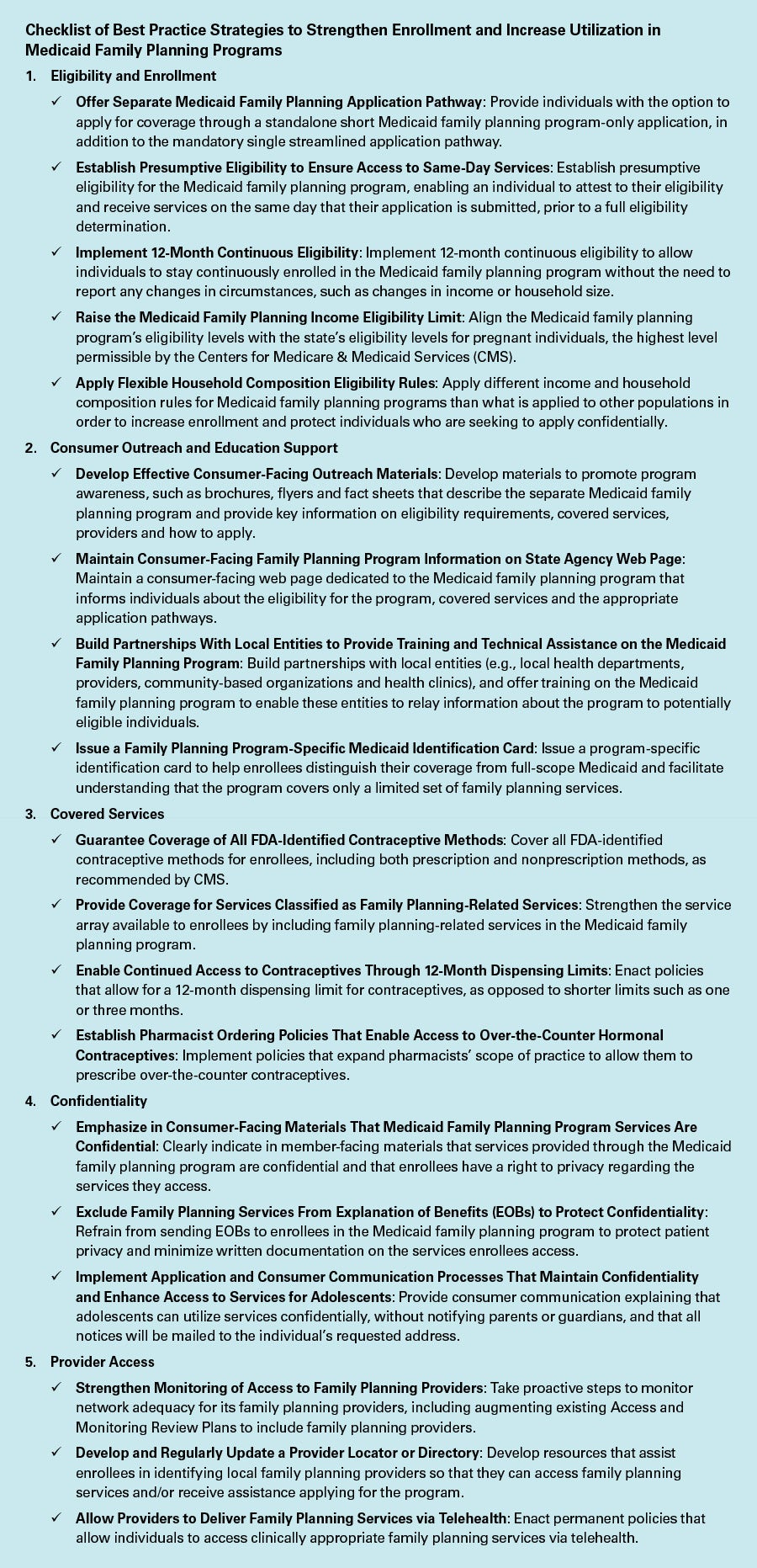Enhancing Access to Medicaid Family Planning Program Services: State-Level Best Practices
Editor’s Note: In a new issue brief prepared with the support of Arnold Ventures, Manatt Health shares an array of best practice strategies in place across the nation to serve as an actionable road map for states that might be considering adopting Medicaid family planning programs, as well as for states with existing programs looking to bolster participation and utilization rates. An executive summary is below. Click here to download a free copy of the full issue brief.
On June 22, Manatt Health will be hosting a webinar on the issue brief that will include an overview of states implementing Medicaid family planning programs, a state-by-state analysis of program enrollment and utilization rates, and a review of best practice strategies for increasing participation and utilization. Click here to register for the free webinar.
Medicaid provides a critical source of health care coverage for low-income individuals in the United States, including 13 million women of reproductive age.1 Medicaid is also the primary source of family planning coverage, accounting for 75% of public expenditures for family planning services in the United States.2 State Medicaid programs have a long-standing requirement to provide family planning services in the benefits package that is provided to people enrolled in full-scope coverage.3 In order to expand the number of people who can access family planning services, states have also taken the option to establish Medicaid family planning programs that cover a suite of family planning services for individuals not otherwise eligible for full-scope Medicaid.
Medicaid family planning programs play a key role in enabling individuals access to family planning services, and they are especially needed in states that have not yet expanded Medicaid to their adult population. To date, 30 states across the country have established Medicaid family planning programs.
States have considerable flexibility in designing their Medicaid family planning programs. As a result, access to and utilization of Medicaid family planning programs are largely impacted by the policies and operational processes a state Medicaid program chooses to implement. The decisions a state makes related to its application process, consumer outreach, confidentiality policies, scope of covered benefits and provider network are all critical programmatic features that determine how easy or difficult it is for an individual to enroll in and receive services through Medicaid family planning programs.
To promote access and utilization, Manatt provides an array of best practice strategies in place across the nation to serve as an actionable road map for states that might be considering adopting such a program as well as states with existing programs looking to bolster participation and utilization rates. The strategies are derived from a review of national literature and policies and practices across the country and informed by an analysis of participation rates and utilization of services in 22 of the 30 states with programs in place.
Conclusion
As the source of critical health coverage for low-income individuals, state Medicaid programs have an extraordinary opportunity and responsibility to ensure enrollment in and utilization of Medicaid family planning programs. The federal opportunities and flexibilities are available, but optimal implementation at the state and local levels requires ongoing attention, engagement and collaboration among state policymakers and program administrators, individuals of reproductive age, providers, and community-based organizations. This can be a time of great opportunity to improve reproductive health care, as an increasing number of states and collaborating partners are focusing their attention on the continuum of reproductive health from family planning to birth and postpartum. The best practice strategies described in this issue brief can help stakeholders identify gaps in current practices, develop effective action plans and create sustainable systems for improving access to critical family planning program services.
1 Guttmacher Institute, Why Protecting Medicaid Means Protecting Sexual and Reproductive Health (March 9, 2017), available at https://www.guttmacher.org/gpr/2017/03/why-protecting-medicaid-means-protecting-sexual-and-reproductive-health.
2 Kinsey Hasstedt, Adam Sonfield & Rachel Benson Gold, Guttmacher Institute, Public Funding for Family Planning and Abortion Services, FY 1980–2015 (April 2017), available at https://www.guttmacher.org/sites/default/files/report_pdf/public-funding-family-planning-abortion-services-fy-1980-2015.pdf.
3 Centers for Medicare & Medicaid Services, Medicaid Covers Family Planning Services (2019), available at https://www.medicaid.gov/about-us/program-history/medicaid-50th-anniversary/entry/47702.

